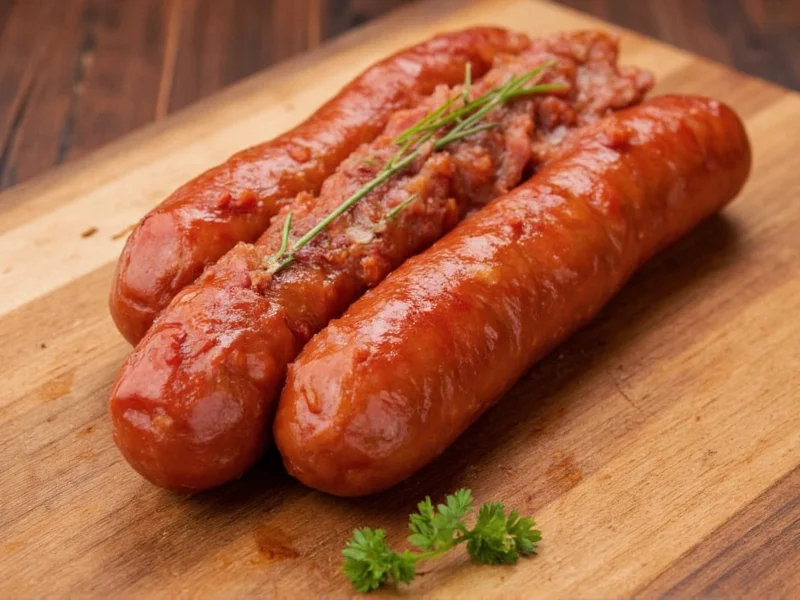Understanding beef sausage links helps home cooks and meal planners make informed choices about this versatile protein source. These cylindrical meat products differ from patties in their casing and shape, creating a distinctive snap when cooked and retaining juices more effectively during preparation. The linked configuration allows for convenient portioning while maintaining freshness until ready to use.
Composition and Manufacturing Process
Beef sausage links begin with select cuts of beef, typically chuck or round, ground to a specific fat ratio between 20-30%. Manufacturers add seasoning blends that may include salt, black pepper, garlic powder, paprika, and natural flavorings. Some premium varieties incorporate wine, cheese, or specialty spices for unique flavor profiles. The mixture gets stuffed into natural casings made from animal intestines or synthetic cellulose casings before being linked into uniform portions.
USDA regulations require beef sausage products to contain at least 65% meat content, with maximum fat content capped at 30%. Products labeled “beef sausage” must derive their primary meat content from beef, though some formulations include small amounts of pork fat for enhanced flavor and texture. Always check ingredient labels if avoiding pork derivatives for dietary or religious reasons.
Nutritional Profile and Dietary Considerations
A standard 3-ounce serving of cooked beef sausage links contains approximately 250-300 calories, 20-25 grams of protein, and 18-22 grams of fat. Sodium content varies significantly between brands, ranging from 400-700mg per serving. When selecting products, look for options with minimal fillers and preservatives for better nutritional value.
| Nutrient | Per 3-Ounce Serving | % Daily Value |
|---|---|---|
| Calories | 270 | 13% |
| Protein | 22g | 44% |
| Total Fat | 20g | 26% |
| Saturated Fat | 7g | 35% |
| Sodium | 550mg | 24% |
For those monitoring sodium intake, seek out “low-sodium” varieties or prepare homemade beef sausage links using reduced-sodium seasonings. Many brands now offer grass-fed, organic, and nitrate-free options catering to specific dietary preferences. When comparing products, examine the ingredient list for artificial preservatives like sodium nitrite, which some consumers prefer to avoid.
Selecting Quality Beef Sausage Links
When choosing beef sausage links at the grocery store, examine several factors to ensure quality. Fresh links should have a bright red color that turns brown when exposed to air – avoid products with grayish discoloration or excessive liquid in the package. Check expiration dates carefully and select packages with the furthest date out. For frozen varieties, ensure no evidence of freezer burn or ice crystals, which indicate temperature fluctuations.
Reading ingredient labels helps identify products with minimal additives. Premium beef sausage links typically contain fewer ingredients with recognizable components. Avoid products listing “mechanically separated meat” or excessive fillers like breadcrumbs and soy protein. Artisanal brands often specify the beef source and processing methods, providing greater transparency about product quality.
Optimal Cooking Methods and Techniques
Mastering beef sausage links cooking time ensures perfect results every time. For stovetop preparation, heat a skillet over medium heat and add links without piercing them. Cook for 12-15 minutes, turning occasionally, until reaching 160°F internally. Adding 1/4 cup of water to the pan and covering creates steam that helps cook the sausage evenly without burning the exterior.
Grilling beef sausage links for BBQ requires indirect heat to prevent flare-ups. Preheat grill to medium (350-375°F), place links on the cooler side, and cook for 15-20 minutes with the lid closed. Rotate occasionally until evenly browned and fully cooked. For oven preparation, arrange links on a baking sheet and bake at 400°F for 20-25 minutes until golden brown and cooked through.
Never pierce sausage links during cooking, as this releases flavorful juices and fats that keep the meat moist. Use a meat thermometer to verify internal temperature rather than relying on appearance alone. Properly cooked beef sausage links should feel firm but not hard, with clear juices when cut open.
Versatile Recipe Applications
While often served as a breakfast item with eggs and toast, beef sausage links offer remarkable versatility across meals. Slice cooked links and add to pasta sauces for rich flavor, or incorporate into stuffing for holiday meals. For a hearty lunch option, place grilled links in a hoagie roll with sautéed peppers and onions. Chopped sausage works well in casseroles, soups, and bean dishes, adding protein and depth of flavor.
When developing a homemade beef sausage links recipe, start with 2 pounds of 80% lean ground beef, 1 tablespoon each of salt and black pepper, 2 teaspoons garlic powder, 1 teaspoon paprika, and 1/2 teaspoon red pepper flakes. Mix gently without overworking the meat, then stuff into casings using a sausage stuffer. Refrigerate for 24 hours before cooking to allow flavors to meld.
Storage Guidelines and Shelf Life
Proper storage extends the freshness of beef sausage links. Unopened fresh links remain safe in the refrigerator for 1-2 days past the sell-by date. Once opened, consume within 1-2 days. For longer storage, freeze links in airtight packaging for up to 2-3 months. When freezing, separate links with parchment paper to prevent sticking and allow for easy portioning later.
Thaw frozen sausage links in the refrigerator overnight rather than at room temperature to maintain food safety. Never refreeze previously frozen sausage unless it was thawed in the refrigerator and remained below 40°F throughout the process. Cooked sausage links stay fresh in the refrigerator for 3-4 days when stored in airtight containers.











 浙公网安备
33010002000092号
浙公网安备
33010002000092号 浙B2-20120091-4
浙B2-20120091-4